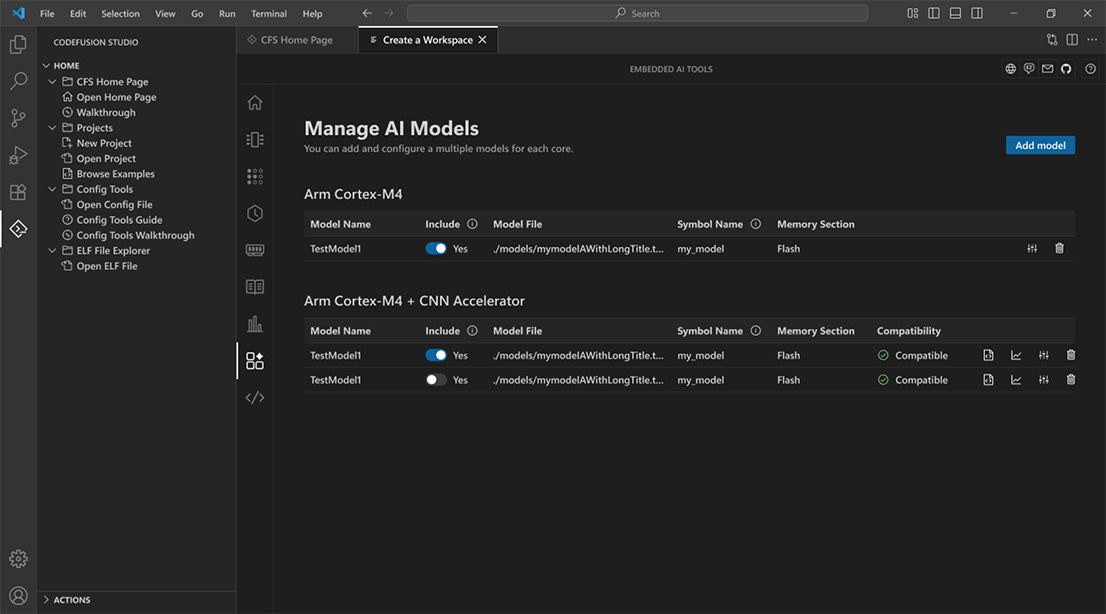blog
November 20, 2025
AI and the Changing Development Landscape
CodeFusion Studio™ 2.0: Bridging Embedded and AI Workflows

AI and the Changing Development Landscape
The role of embedded software has expanded far beyond classical control code. Devices at the edge now combine real-time processing, connectivity, and machine-learned intelligence in a single platform. This shift is creating a demand for a development environment that is more capable, and far more demanding, than anything the tools of the past were designed for.
Why AI Matters for Embedded Developers
Embedded teams used to focus on managing constraints: tight power budgets, limited memory, and hardware quirks that made every project unique. The tools reflected those boundaries, compilers, debuggers, and maybe a peripheral configurator if you were lucky.
That model no longer fits. Developers are now expected to integrate ML workloads, manage heterogeneous multicore SoCs, meet strict security requirements and still deliver on aggressive schedules. Traditional toolchains have become a point of friction rather than an enabler.
The New Reality: AI at the Edge
Current SoCs operate more like distributed systems with their own ecosystem than simple microcontrollers. They combine heterogeneous cores, accelerators, DSPs, and specialized domains that must work together. Each core might use a different instruction set, memory space and toolchain. Developers must coordinate across boundaries, debug across architectures, and still deliver deterministic performance.
![[object Object]](/api/media/file/2025-11-20-cfs-p2-47mc1h.jpg)
At the same time, AI/ML is now central to edge applications. Developers must bridge the gap between data science and embedded workflows by moving from model training in frameworks like PyTorch or TensorFlow to deployment on constrained hardware. This means handling quantization, optimization, hardware mapping, and code generation, all while maintaining security and compliance. Essentially, there is a need for a new unified workflow that spans two worlds where data-centric model development and deterministic embedded deployment becomes the new norm.
The Challenge: Tooling That Keeps Up
Most IDEs treat AI as an afterthought. Developers end up stitching together scripts, external tools and manual processes to move models from development to deployment. These fragmented workflows slow teams down, introduce security risks and make reproducibility difficult.
What’s needed is a platform that matches the complexity of today’s systems. A development platform that reflects the reality of modern systems and supports the full lifecycle: embedded code, ML models, hardware mapping, complexity abstraction, run time optimization and secure deployment to build intelligent solutions.
CodeFusion Studio™ 2.0: Bridging Embedded and AI Workflows
This is where CodeFusion Studio 2.0 steps in. Designed as a hybrid bridge between embedded software development and AI workflows, it’s a developer-first environment where MCU bring-up, SoC resource allocation, AI model integration and system security converge in one workspace and one single environment to unify the full development lifecycle.

What Makes CFS 2.0 Different?
- AI-Native IDE: AI workflows are core elements, models aren’t handled as external artifacts. Import models from TensorFlow Lite, PyTorch, ONNX, or ADI’s Model Zoo, validate them against the target and generate optimized inference code in minutes within the IDE.
- End-to-End Pipeline: From model import and compatibility checks to runtime profiling and deployment, CodeFusion Studio 2.0 streamlines the full ML lifecycle without leaving the workspace.
- Integrated Zephyr-Based Profiling: Monitor timing, latency, throughput, memory, and power consumption on real hardware with built-in profiling tools. This is of high value for deterministic, resource constrained systems and complex SoC devices.
- Security at the Core: Trusted Execution Environments, secure boot, and cryptographic primitives are built in, not bolted on.
- Zero-Touch Evaluation: With more to come to Test models remotely on ADI hardware without physical boards required.
Developer Experience: AI That Adapts to You
CodeFusion Studio 2.0’s UX research shows that AI in developer tools must adapt to the engineer’s experience level and working style. Some see AI as a peer that accelerates coding, debugging, and documentation. Others value its role in filtering complex references and offering context-aware support. The imperative is clear: AI should be tunable, context-aware, and flexible, meeting engineers where they are, whether novice or expert.
Real Value: From Vision to Reality
With CodeFusion Studio, what once took weeks can now take hours. Developers can import a trained model and have inference-ready code running on a complex SoC in under 15 minutes. Debugging cross-core issues is no longer a multi-day ordeal. Resource allocation, configuration and security are all managed from a single dashboard.
The result? Embedded teams move faster, collaborate better, and deliver smarter solutions. AI is no longer a barrier, it’s an accelerator.
Looking Ahead
AI is reshaping embedded development, but only for those with the right tools. CodeFusion Studio 2.0 is proof that the future of embedded development doesn’t have to be fragmented. It can be open, elegant, and AI-ready.
Ready to see what’s possible? Explore CodeFusion Studio and start building the future today.